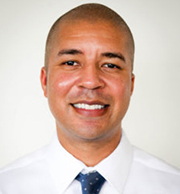
Stand Up, Stand Together
By Damien Sweeney, Ed.D. | November 2021

 Our world is finally opening its eyes to the fact that, for so long, Black lives have been treated as dispensable by many. Health care, law enforcement, our economic system and, yes, even our nation's educational systems have had a long history of treating Black lives differently.
Our world is finally opening its eyes to the fact that, for so long, Black lives have been treated as dispensable by many. Health care, law enforcement, our economic system and, yes, even our nation's educational systems have had a long history of treating Black lives differently.The one thing I can absolutely say about all school counselors, no matter where you are from or where you work, is that you got into this field because you have a heart to help and heal. That’s great news, and this is your time to continue doing just that. This article offers some next steps school counselors across America can take to fight for social justice and equity.
Remember, equality and equity are not the same. Equity is the process of providing what each individual needs to help create an equal playing field. The Opportunity Myth verified that the oppression and discrimination found throughout history are still happening to Black (and Latinx) students in schools. This suggests we have a systemic problem with the way we teach our traditionally marginalized students.
In essence, society oppresses, discriminates and creates negative fictions/narratives about people of color. These fictions suggest that Black people are violent, criminal, animalistic, etc., according to a 2019 paper from Forward Promise. Next, society creates dangerous actions toward people of color that can manifest themselves as police brutality (George Floyd, Breonna Taylor, Botham Jean, Philando Castile) or the murder of innocent Black men and women as a result of flat-out racism, mislabeling and negative stereotypes by other citizens (Ahmaud Arbery, Trayvon Martin).
These two actions, coupled together, can give Black people and other people of color harmful internal feelings such as, “I’m no good. I’m not smart. I’m worthless. I’m unlovable. I’m wicked or evil.” These lead to destructive external reactions, which may look like harm to one’s self or others. It is time for us to each reflect on how our individual perceptions, actions and/or lack of action perpetuate dehumanization on a micro level in all that we do.
Where can school counselors start in the fight for social justice?
Educate Yourself to the Complexity
In “Pedagogy of the Oppressed,” Paulo Freire wrote about how we must liberate students who have lived within a system of oppression. First, we must understand the dynamics of systems of oppression, educate ourselves about how these function within education, and understand our role to mediate both dehumanization and dynamics of oppression that exist often without question. These are invisible forces that for most of us have never been articulated. We each need to do the difficult work of identifying and then challenging the biases we hold that were programmed into us – without shame and without blame.
Use Your Advisory Council
These stakeholders can discuss how school counselors can address the race-based stress and trauma Black people are forced to endure throughout the country (broadly) and in their schools (specifically).
Use Tier 1 Direct Student Services
This includes school counseling lessons for all students. Talk to students about racism, oppression and discrimination. Teach them how to be upstanders. If you are like me, you may, at times, be concerned about the safety of the upstander along with the target of racism or bullying. Create a protocol allowing students to report instances of racism safely and explain this protocol in your Tier 1 classroom lessons.
When creating your lessons, remember you are working with students from various backgrounds who sometimes sit in desks all day long. Can you create an engaging lesson? Can you get your students moving? How can you create a truly safe space for students that allows them to do most of the talking?
Encourage the teacher to stay in the room and participate in the activity if possible. Now you are teaching a lesson through a social/emotional learning (SEL) lens and also modeling the importance of SEL for teachers so they can incorporate it in future lessons.
Raise Awareness of Microaggressions through Tier 2 Services
In every school, it is nearly inevitable that some students, families or colleagues have been a victim of racism or witnessed it. Sometimes racism is not overt. “Microaggressions are comments or actions that subtly and often unconsciously or unintentionally express a prejudiced attitude toward a member of a marginalized group” (Merriam-Webster, 2021). These subtle comments and actions add up to be extremely hurtful.
For the targets of racism (overt or microaggressions), Tier 2 direct student services will be needed, as individual or small-group counseling. As a music lover, I often incorporate music in my small groups. Music can bring us together and the right song often finds the words to convey exactly what we are feeling. What emotions does “Home” by Machine Gun Kelly or “Freedom” by Beyonce and Kendrick Lamar produce in your students? So many great songs are out there, and you and your students can choose songs that convey emotion and produce a foundation for dialogue. I’ve also found that giving students a blank sheet of paper and a pen to write or draw helps them find the words or gives them a chance to connect what they are feeling to a piece of art.
Here is the hard part. Tier 2 direct student services for race-related stress and trauma are not only for victims of racism. These services are also for students who perform racist acts (sometimes unknowingly). What will individual or small-group counseling look like for these students? Remember, school counselors help all students learn and grow. We intervene to teach the whole child, so you need a plan to address these students’ actions and how you will maintain your composure during difficult conversations.
Address Tier 3 Needs
What systems are we using to identify students in crisis at risk of harming themselves or others? Is there any way our own conditioned lens causes us to miss students in desperate need of our support?
Consider both data housed inside the school’s computer systems and data collected from being present in our school. Data drives our work, and we are fortunate to have a bird’s-eye view of our entire school and the data that shows progress or obstacles. I like to refer to A (attendance), B (behavior), C (course passing- otherwise known as achievement) data. Perhaps our data-driven framework can expand to include data collected on student voice that we can explore by student groups (poverty, race, special education, etc.) to drive our programs and services.
Explore School Trends
Are your school’s traditionally underrepresented students’ attendance, behavioral or course-passing data deficient compared with their white counterparts? If so, why? Are your school’s traditionally underrepresented students getting the same opportunities and access to gifted and talented programs, Advanced Placement classes, career and technical education and dual-enrollment classes as their counterparts? If not, why?
These are systems questions requiring us to look in the mirror and ask questions that are tough for entire organizations (schools or districts) to face. To help, look at the Continuum on Becoming an Anti-Racist Multicultural Organization. This framework should not be completed by school administrators only, but should include voices from all stakeholders – teachers, students, families, community members – and strive to create real change for schools.
Further Education
If you haven’t seen the ASCA Town Hall: Racism in Schools, please do so. The panelists remind us that our willingness to take risks, speak out and become vulnerable is invaluable. They address the ASCA Ethical Standards for School Counselors. As a quick reminder, creating equitable policies to give your minority students opportunities is, quite literally, your job; see ASCA Ethical Standards B.2.i. and B.2.o.
Because many school counselors across the country don’t have the lived experience of racism, knowing how to facilitate conversations about race, racism or race-related stress and trauma may be difficult. You may not know where to start. At the Kentucky Department of Education, we created the document Guidance on How Districts Can Facilitate Conversations About Race-based Stress and Trauma. Some of the first steps (from this document) you can take in your journey include:
- Provide Tier 1 instruction to students and staff members about cultural humility, equity, etc.
- Implement Tier 2 intervention services for students and staff members who are struggling with understanding these concepts or for students and staff members who are victimized by events that have happened in their own lives, their own community or the world.
- Prepare information about Tier 3 intervention services with community agencies for students and staff members who might have reached a point where they are a danger to themselves or others.
Don’t try to be anyone but yourself. You are enough, and by leaning into these issues while having a desire to fight for social justice, you will find the best way possible to reach your students and educate them on the many negative effects of racism, oppression and racialized trauma.
Damien Sweeney, Ed.D., is the former program coordinator for comprehensive school counseling with the Kentucky Department of Education (KDE). He recently has been named director of diversity, equity and inclusion at KDE. He can be reached at damien.sweeney@education.ky.gov.